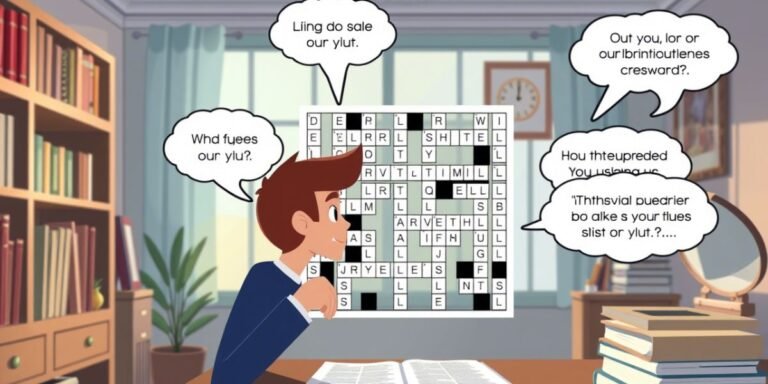If you enjoy solving the New York Times crossword, you’ve likely come across some head-scratching clues that seem simple at first but require a clever twist in thinking. One such clue is “Bumped Things NYT Crossword.” It’s a short phrase that appears from time to time in NYT puzzles, and while it might sound vague, it has a surprisingly consistent and logical answer.
In this article, we’ll break down what this clue actually means, why it appears so often, and how you can solve it with confidence the next time it shows up. We’ll also look at other possible answers, common mistakes, and expert tips to help you master similar clues.
What Does “Bumped Things” Mean in Crosswords?
The phrase “bumped things” might seem general, but in crossword language, it’s a classic example of a clue that requires lateral thinking. It doesn’t describe objects being bumped by something, but rather things that are likely to do the bumping—often unintentionally.
Most Common Answer: ELBOWS
The most frequent answer to “bumped things” in the NYT crossword is ELBOWS. Why? Because elbows are the part of the body that tend to stick out. Whether you’re squeezing through a crowd, reaching across a dinner table, or gesturing while talking, your elbows are often the first to bump into nearby people or objects.
It’s simple, relatable, and makes perfect sense once you think about it.
Why ELBOWS Makes Sense
Elbows protrude from the body.
They often collide with people or things.
The word “elbows” fits neatly into a crossword grid with common letters.
Crossword Context: Why This Clue Keeps Appearing
The New York Times crossword is carefully crafted by expert constructors who aim to balance challenge with fun. Certain clues, like “bumped things,” appear repeatedly because they:
Are easy to clue but not obvious to solve
Use everyday vocabulary (like elbows or knees)
Have common letters, which helps in puzzle construction
Appeal to solvers with their subtle wordplay
This is part of what makes the NYT crossword so beloved — it’s not just about definitions but about patterns, inference, and language play.
How to Solve Clues Like “Bumped Things”
Even seasoned solvers sometimes pause when they see a vague clue like this. The trick is to shift your thinking from literal to practical and imagine scenarios where “bumping” happens.
Think of Body Parts or Contact Points
Start with what makes contact: elbows, knees, hips, shoulders, or heads. These are the likely suspects.
Use the Grid: Letter Count and Crosses
Let’s say the clue is for a six-letter word. That instantly narrows it down. If you already have a few letters from intersecting words, try plugging in possibilities.
For example:
_ L B _ _ S → Most likely ELBOWS
Don’t Overthink It
One common mistake is assuming that the clue must have a tricky, hidden meaning. In reality, it’s usually just a clever play on something obvious. “Bumped things” = parts that bump = ELBOWS.
Alternate Answers and Variations
While ELBOWS is the most common answer, it’s not the only one. Depending on the puzzle’s construction and theme, other answers can fit too.
Other Possibilities:
KNEES – Another body part that often bumps into things.
HEADS – Especially in phrases like “bumped heads” or accidental headbutts.
HIPS – When navigating tight spaces or dancing, hips can bump.
TOES – Stubbed toes are a type of “bumped” object.
Pro Tip: Always count the letters and check the crossing answers. The best guess is the one that fits all directions.
Common Pitfalls to Avoid
Solving crossword puzzles is a skill that gets better with practice. Here are a few common errors to watch out for with clues like “bumped things”:
Taking the Clue Too Literally
Don’t get stuck thinking about physical objects like “cars” or “boxes.” Crossword clues often stretch meanings.
Ignoring the Letter Count
Forcing a word that doesn’t match the clue’s letter requirement will throw off the entire grid.
Forgetting About Wordplay
NYT crosswords love puns, metaphors, and clever misdirection. “Bumped things” isn’t about accidents—it’s about what usually bumps.
Quick Reference: Crossword Solving Tips
Memorize frequent answers: Words like ELBOWS, ERA, ARIA, and OLE appear often.
Look for context: Is the clue plural? Past tense? That helps you figure out the answer’s form.
Use the crossings: Let other answers guide you to the right word.
Practice daily: The more you play, the more patterns you’ll recognize.
Stay patient: Even tricky clues become obvious after you’ve seen them a few times.
Conclusion: What to Do Next Time You See This Clue
When the clue “bumped things” shows up in your next NYT crossword, take a deep breath and think about the everyday moments when we bump into others. Elbows will likely be your first and best answer. But as always, double-check with crossing clues to be sure.
Solving crosswords is a mix of logic, language, and a little bit of fun. The more clues like “bumped things” you master, the quicker and more confidently you’ll solve future puzzles.
FAQs About “Bumped Things” NYT Crossword
Q: Is “ELBOWS” always the answer to “bumped things”?
A: Not always, but it is the most frequent and likely answer, especially if the clue has six letters. Always verify with the grid and other intersecting clues.
Q: What other answers have been used for this clue?
A: Occasionally, answers like “KNEES,” “HIPS,” or “HEADS” might appear, especially if the puzzle’s theme supports them.
Q: Why do constructors like this clue?
A: It’s short, clever, and uses a simple idea that’s relatable. Plus, “ELBOWS” contains common letters, which makes it easy to work into a crossword grid.
Q: How can I improve at solving clues like this?
A: Practice is key. Also, read books or blogs about crossword solving, follow crossword communities, and take note of clues that repeat over time.
Final Tip: Don’t be afraid to guess, erase, and rethink. That’s part of the puzzle’s magic.
Happy solving!

